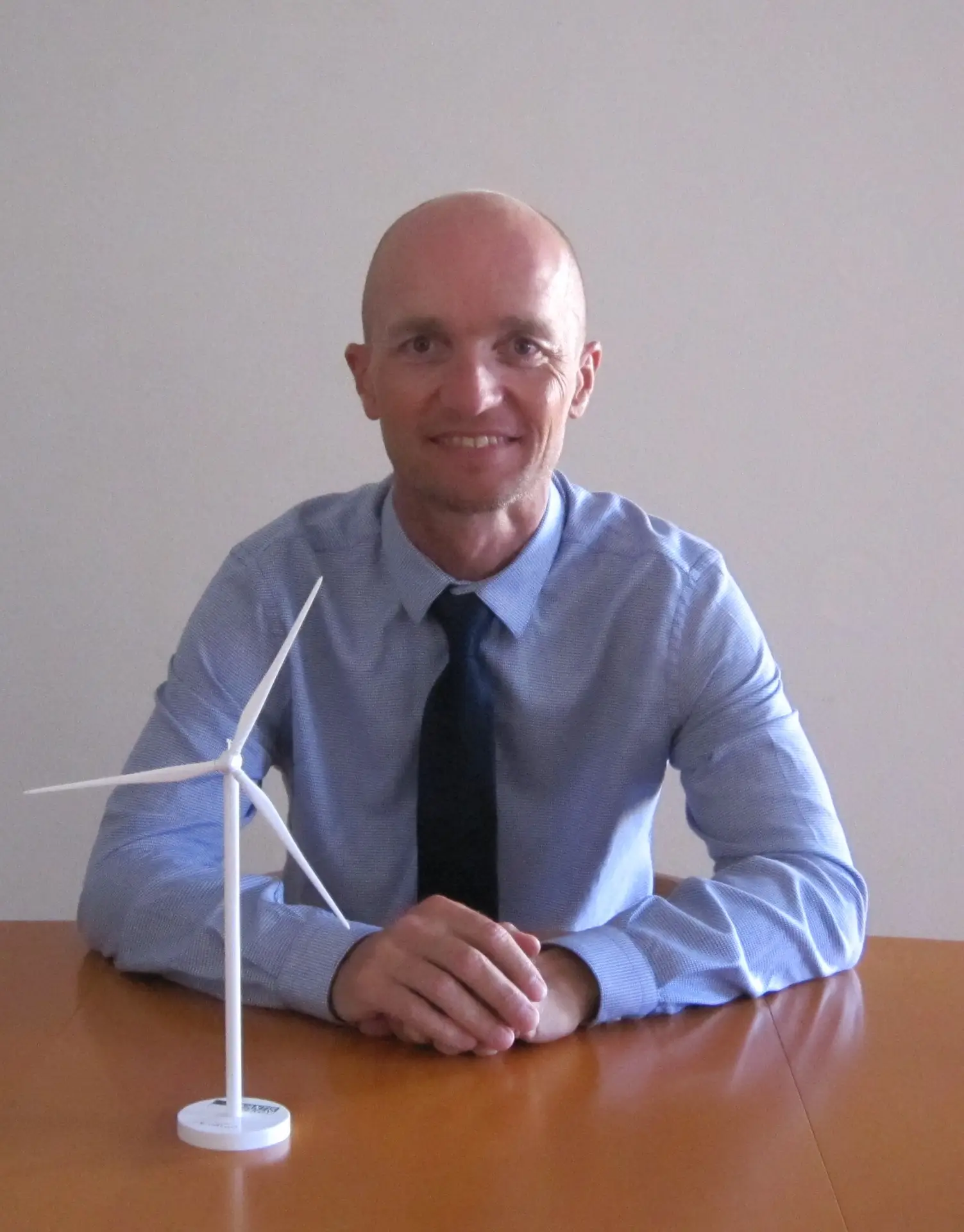The most accurate ADLS. From the German experts – for your wind turbines.
Turbines under contract
Receivers installed
Wind farm turned dark
Wind turbines are equipped with obstruction lights to be visible in the dark for air traffic. Those obstruction lights blink from dusk till dawn, no matter if an aircraft is nearby or not. This constant blinking has proven to be an obstacle in the acceptance of wind power.
To stop the unnecessary blinking and to make the night sky dark again, there is a technology called Aircraft Detection Lighting System or Aviation Detection and Obstacle Lighting System, ADLS for short.
Through ADLS, it is possible to turn off the blinking obstruction lights of wind farms. This is done by monitoring the airspace around a windfarm. The obstruction lights of the wind turbines are only activated when an aircraft is in the vicinity.
In Germany, the use of ADLS on wind turbines is required by law. Following a recent extension, the implementation deadline for operators is January 1, 2025. With this expertise, we are committed to bringing ADLS to other countries as well.
The light:guard system for Aircraft Detection Lighting System is type-tested and meets IEC and ICAO standards. We already equipped some wind farms abroad with our ADL system and would be more than happy to provide you with a customized solution.
Find out about the legal situation of ADLS in your country
The United Kingdom is the sixth largest country in the world in terms of installed wind power capacity with 28.5 GW in 2023. For the first time, wind became the main source for electricity in May 2023.
Despite this, there is still no proper legislation on ADLS in the UK, but discussions have been initiated. The relevant entity is the Civil Aviation Authority (CAA), which is the statutory corporation that oversees and regulates all aspects of civil aviation in the United Kingdom.
It is believed that Aviation Detection Lighting Systems will be an issue in the coming years. The company ScottishPower Renewables wrote a proposal to the CAA in 2021 to mitigate the visual impact by obstacle lighting of wind farms. This proposal also contained the possibility of installing transponder-based ADLS.
The CAA responded to the proposal with a letter, explicitly citing Germany’s legislation as a model for the future. Therefore, a regulation on transponder-based ADLS can be expected in edition 7 of CAP 764: CAA Policy and Guidelines on Wind Turbines.
Operators and project planners in the United Kingdom who are interested in reducing visual impact and raising acceptance for their projects can contact us to get a head start on this.

Germany has been the pioneer in the field of Aircraft Detection Lighting Systems. With some companies operating as early as 2008, the first mandatory regulations were adopted in the Renewable Energy Sources Act (EEG in German) in 2019. This law states the obligation for all wind turbines that measure over 100 meters in height and have been put into operation after 2005 to be equipped with a transponder-based ADLS. Since then, the deadline has been postponed four times and eventually has come into effect as of January 1, 2025.
Due to this regulation, nearly all existing wind turbines in Germany have been equipped with an ADL system and most are already dark at nighttime. If that’s not the case, operators can face harsh penalties. According to § 52 EEG, the penalty amounts to 10 euros per kilowatt of installed capacity of the system and calendar month. For a 3.5 megawatt turbine, this equates to 35,000 euros per month.
Of course, the requirement for ADLS also applies to new wind turbines. Project planners and operators must therefore have the topic of ADLS on the agenda even before the construction of a new wind farm. ADLS providers and turbine manufacturers have optimized their processes for this in recent years. Some manufacturers can deliver the ADLS components directly from the factory so that ADLS is also available when the wind farm is commissioned.
Light:Guard already monitors almost the entire German airspace and covers one seventh of the area of Germany. In these areas, new ADLS systems can be put into operation almost immediately.
If you are a project planner with upcoming wind farm projects in Germany, do not hesitate to contact us. We will be happy to support you with our experience from over 700 wind farms equipped with the light:guard system.

The Netherlands is a pioneer in many fields, wind energy and ADLS being no exception. After Germany, the country has been one of the early adopters, giving it the name “Naderingsdetectie”. As opposed to their eastern neighbors, Dutch wind farm operators are not obliged to equip their turbines with ADLS.
It is however, encouraged, to avoid nuisance throught light pollution for residents and raise acceptance for wind energy. Hence, provinces are being supported by subsidizing the installation of Aircraft Detection Lighting Systems.
Light:Guard has joint forces with Topwind BV, which exclusively distributes the light:guard system in the Netherlands. The system has been tested and approved by the responsible authority Inspectie Leefomgeving en Transport (ILT). The most notable of many successful projects was the implementation of the light:guard-system at Windplan Groen, leading to over 97% lights-off-time.

France is one of the biggest wind energy producers in the world, ranking seventh in installed capacity. As of 2025, all these wind farms are still blinking at nighttime and no legislation has been made to reduce this disturbance to residents and nature alike.
Discussions about adopting a legislation on Aircraft Detection Lighting Systems for wind turbines are underway though. The regulatory framework is changing and is currently being discussed by various authorities, such as the renewable energy association France Renouvelables and government and aviation authorities.
There is already a french name for the technology: Balisage circonstancié des éoliennes, which translates to “detailed marking of wind turbines”.
Light:Guard is already active in France. Since 2024, we have been testing a transponder-based Aircraft Detection Lighting System – or balisage circonstancié des éoliennes – on French territory.

Austria introduced Aircraft Detection Lighting Systems (ADLS) for wind turbines in 2024. The corresponding law was was passed by the Federal Council in April. In June, the Federal Ministry for Climate Protection announced that demand-based night-time identification would initially be introduced on a voluntary basis. Originally, there was talk of an obligation as in Germany.
In Austria, however, it is regulated differently. In Germany, each wind farm obtains its own ADLS system from a provider. In Austria, Austro Control will be centrally responsible. It monitors Austrian airspace and delivers the ADLS signals to the wind farm. A fee is charged for this. The wind farm must be able to receive and process the signal in order to control the suppression of the lighting.
As an experienced ADLS expert with many systems in use, Light:Guard has worked out a turn-key solution specialized for Austrian operators. The offer includes:
Upgrade of the wind farm infrastructure and ADLS-capable fires in coordination with the OEMs
Takeover of the application process
Installation of the ADLS server (LCU-T) in the wind farm as an Interface to the Austro Control API
Recording of all operating conditions and creation of reports about the light:guard system
Our Light Control Unit (LCU-T) works with all turbine types and is offered as a standard ADLS interface by Nordex, for example.

In relative Terms, Denmark is the biggest wind energy producer in the world. Despite only ranking 17th in total capacity, Denmark is generating nearly 60% of their electricity through wind power – a higher share than any other country.
However, no regulation regarding Aircraft Detection Lighting Systems has been made until now. This will change in the upcoming months: Danish authorities are working on a legislation, which is expected to come into effect 2026.
Wind farm operators in Denmark will then be allowed to equip their turbines with an ADLS to reduce nuisance for residents from light pollution. As opposed to Germany, the legislation will not be mandatory and allowing different means of technology. This means that both radar and transponder based ADL systems can be installed.
Light:Guard, in cooperation with sister company Senture GmbH, can offer all of those solutions to Danish wind operators. Feel free to contact us for more information regarding legislation or starting a pilot project.

On January 1, 2024, the Norwegian Civil Aviation Authority introduced the “Regulation on reporting, registration and marking of aviation obstacles“. These regulations establish clear guidelines for systems designed to manage the activation of warning lights on wind turbine structures, ensuring they are only illuminated when necessary. The goal is to minimize light pollution while maintaining the highest standards of safety for aviation.
One of the standout features of the new regulation is the requirement for a dual detection system that combines Primary Surveillance Radar (PSR) and Secondary Surveillance Radar (SSR) with transponder interrogation. This combination ensures comprehensive detection of all aircraft, including those not equipped with transponders, providing an additional layer of safety.
By leveraging this technology, wind farms can effectively balance aviation safety with environmental and community considerations, addressing concerns about continuous nighttime illumination from obstacle lights, which can be disruptive to residents and wildlife.
For several years, the Norwegian Civil Aviation Authority, Luftfartstilsynet, has approved the use of ADLS on a case-by-case basis. With the publication of formal requirements in 2024, ADLS is now expected to become a more common feature of wind farm developments across Norway.
By adhering to these new regulations, the wind energy sector in Norway can ensure that growth in renewable energy does not come at the expense of safety or quality of life. This balance is essential for fostering public support and ensuring the long-term success of wind energy initiatives.
Light:Guard’s sister company, Senture GmbH, is currently developing several ADLS projects in Norway. Senture’s ADL systems meet the stringent national requirements, and they bring valuable experience and expertise to these developments.
Visit their website adls.org to learn more about regulations in Norway and how they can help you with their experience.

South Africa’s renewable energy sector is experiencing rapid growth, with a strong focus on solar and wind power. As a result, strict regulations governing energy production are anticipated to ensure supply security and grid stability. At the same time, efforts aim to minimize the impact of this expansion on local communities, South Africa’s rich biodiversity, tourism, and the preservation of the country’s unique natural beauty.
Among these efforts, the reduction of avoidable light pollution is becoming an increasingly important goal, paving the way for Aircraft Detection Lighting Systems (ADLS) technology. To protect South Africa’s stunning natural landscapes, ADLS is particularly expected to be implemented in rural areas, tourist destinations, and wildlife reserves.
Currently, South Africa lacks binding national regulations for ADLS. Instead, project-specific requirements are applied, following guidelines from the ICAO and FAA. The precise implementation often depends on location-specific factors, such as the local fauna and environmental conditions.
Radar-based Aircraft Detection Lighting Systems utilize radar technology to detect aircraft near wind turbines. These systems are capable of identifying all flying objects, whether or not they are equipped with transponders. They may use primary radars (PSR), secondary radars (SSR), or a combination of different technologies.
Light:Guard’s sister company, Senture GmbH, specializes in radar-based ADLS and is already active in South Africa. Visit their website at adls.org to learn more and discover how you can be at the forefront of reducing light pollution from wind turbines in South Africa.

Aircraft Detection Lighting Systems are a fairly new technology which many countries have yet to adopt, following the success from places like Germany.
Thus, your country might not have any regulations regarding Aircraft Detection Lighting Systems. But why not be a pioneer? Contact us and we will find out if a pilot project is feasible. Like Windplan Groen in the Netherlands with over 97% lights-off-time, for example.
Find out about our offer and requirements for a pilot project in your country:

Every flying object is obligated to send out transponder signals to be identifiable. Those are being received by the Light:Guard receivers.
The system receives continuous data from all receivers at once and is therefore able to achieve a higher network coverage than each individual receiver would by itself.
This leads to a better signal quality and higher light-off times for each wind turbine, especially in areas with high air traffic or large wind farms.
to all operators whose wind turbines are configured for ADLS connection
what we accomplished so far
Light:Guard has equipped all commissioned existing turbines in Germany with ADLS and thus fulfills the legal requirements at all wind farms. However, new turbines must also be equipped with night-time marking in line with requirements.
These figures illustrate the work steps from commissioning to the finished dark wind farm and show you how much we have already implemented on the way to this goal.
An explanation of the individual steps can be found by moving the mouse pointer over the question mark (?) next to the text.
Receivers installed: the Light:Guard Receiver (LGR) receives transponder signals from the flying objects
and can recognize whether one is in the vicinity. Not every wind farm needs its own receiver.
Receivers online: these receivers are currently transmitting data and form our receiver network.
Multilateration (see above) is therefore already possible throughout Germany.
Light Control Units installed: the Light Control Unit (LCU-T) is the interface that
controls ADLS in the wind farm. Usually every wind farm requires an LCU-T.
Light Control Units online: These LCU-Ts are connected to our system.
Everything is installed in these wind farms and ADLS is theoretically functional.
Wind farms measured: each individual ADLS requires such a survey or site-specific
proof of functionality. Transponder signals are sent to the receiver and thus simulate
a flying object. Only then can ADLS be approved and activated.
Wind farms fully certified: the certificate is confirmation for the authorities that our ADL system
is functioning properly, meets the requirements of the AVV and can be activated. Some ADLS manufacturers
already count this as "turned dark". However, this is not entirely correct. For the lights to go out,
the final approval from the authorities and signal transmission by the system manufacturer is still missing.
Wind farms turned dark: approval has been given by the authorities, the turbine manufacturer
forwards the signal. The ADL system is active and the lights in the wind farm are off. This is how it looks like: ADLS in action (Video).
last updated: 1st April 2025
Send us an inquiry and we will be happy to provide you with an individual and non-binding offer.
Wind turbines, officially known as wind turbines, flash to make them visible to air traffic in the dark. This is intended to prevent collisions with airplanes and helicopters. In Germany, this obstacle marking is regulated by the “General Administrative Regulation on the Marking of Aviation Obstacles” (AVV marking for short). According to the AVV, wind turbines must be marked from a height of 100 meters. To ensure that they no longer flash all night, the use of an Aircraft Detection Lighting System will be mandatory from 2025.
Wind turbines flash red at night in order to be visible. This night-time marking is carried out by means of so-called hazard lights, fire W red or blade tip lighting. The color and light intensity are prescribed. Daytime marking is also mandatory on wind turbines. However, this mainly includes the stripes on the turbine (see question after next). In some cases, wind turbines also flash white light during the day, but this is the exception.
The flashing pattern, color and intensity are prescribed by the aviation authority. It depends on the type of lighting installed. Fire W red, for example, flashes in the specified sequence 1s on/0.5s off/1s on/1.5s off.
The stripes on wind turbines are part of the daily marking. The day markings are usually made using colored markings. These can be attached to the mast and rotor blades.
An orange or red stripe six meters wide is required on the rotor blades from a total height of 100 meters.
The mast must be marked at a height of 40 ± 5 meters above the ground. An orange or red colored ring three meters wide (six meters for lattice masts) should be used. This is required if the total height exceeds 150 meters. It is also required if the total height exceeds 100 m and the machine house is not marked. In this case, the second orange or red stripe on the rotor blades is also dispensed with.
Aircraft Detection Lighting Systems (ADLS) offer several advantages:
Reduced light pollution: less night-time lighting means less disturbance for residents and nature.
Increased acceptance of wind power: Residents are more willing to accept wind turbines in their vicinity if night-time lighting is minimized.
Energy savings: Lighting is only used when it is really needed, which saves energy.
Precise predictions with percentage values are difficult to make across the board. In some wind farms, the light:guard system achieves light-off times of almost 100%. However, it depends very much on the location and the region. Next to an airport, the reduction in lighting is not nearly as significant. The flight activity is simply too high here. In general, of course, the safety of air traffic must be guaranteed. For this reason, it does not make sense to state or interpret percentages regardless of location.
An example of an ideal case is the wind farm Groen in the Netherlands. Here, the light:guard system was able to reduce flashing by over 97%, despite high flight activity. The exact results can be found in this case study.
There are two approaches to this: Multilateration and Single Receiver Approach.
Multilateration: With this method, the position of an aircraft is determined by receiving transponder signals at several receivers. The signals are received at different locations and the time differences are used to calculate the exact position of the aircraft. This method is very precise and can also accurately determine the altitude of the aircraft. However, it requires several receivers, which increases the costs and installation effort.
Single Receiver Approach: This method uses only one receiving station to receive the signals from transponders. The position of the aircraft is estimated based on the strength and direction of the received signal. This method is less accurate than multilateration and can have difficulties in determining the exact altitude. However, it is cheaper and easier to install as only one receiving station is required.
Multilateration (MLAT) is a well-known and proven method in aviation. The position of a flying object is calculated by measuring the different arrival times of the same radio signal at different receivers. The light:guard system for Aircraft Detection Lighting System works at most locations by means of multilateration and can therefore achieve particularly accurate results. Multilateration requires the following elements:
Transponder receiver (Light:Guard receiver): There are several transponder receivers at known locations with synchronized clocks. These receivers receive the transponder signals transmitted by airplanes.
Time measurement: When an aircraft transmits a transponder signal, this is received by the various transponder receivers. Each transponder receiver measures the time it takes for the signal to reach it.
Triangulation: Positions can be calculated using the time differences in the transponder signals between the various transponder receivers. This is done by triangulation. The position of the aircraft is determined by the intersection of the time measurements from different receivers.
Error correction: As the transponder signals require a certain amount of time to reach the receivers, a number of factors must be taken into account. These factors are the transit time of the signal, possible reflections and atmospheric conditions. Algorithms correct the errors and calculate the exact position of the aircraft.
A transponder is an electronic device that is installed in aircraft. It emits a signal that is received by radar systems on the ground. This allows the position and altitude of the aircraft to be precisely determined. In aviation, transponders are used to make the position and altitude of an aircraft visible to air traffic controllers on the ground.
Since there is no regulation on the topic in English language, a number of synonyms are being used, Aircraft Detection Lighting System (ADLS) being the most common one.
Others include:
Transponder-based ADLS: With these systems, the position of flying objects is determined by the transponder signals they emit. Only flying objects equipped with a transponder are recognized. These systems are very accurate and require less infrastructure on the ground.
Radar-based ADLS: These systems use radar signals to detect aircraft in the vicinity of wind turbines. They can detect all flying objects, regardless of whether they have a transponder or not. However, radar ADLS requires more technical infrastructure and can be more expensive to install and maintain.
Active and passive radar are two different types of radar systems.
Active radars actively emit signals that are reflected by an object and then received by the radar. The time it takes for the signal to return is measured to determine the distance and speed of the object.
In contrast, passive radars receive signals emitted by other sources, such as radio or television transmitters. Based on the interference or changes in these signals, a passive radar can detect objects without emitting signals itself.
Both types have their own advantages and disadvantages, such as the stealth characteristics of passive radar, which can make it more difficult to be detected by traditional active radar systems.
The Light:Guard receivers cover almost all of Germany with their reception radius. 50,000 km² of this area has already been surveyed and certified in accordance with AVV. New ADLS systems can be put into operation very quickly in this area.
Wind farms in one of the surveyed areas can receive ADLS in eight weeks. If the systems are ADLS-compliant, we guarantee installation and certification within eight weeks. By sending us a brief inquiry, we can quickly find out whether your wind farm is eligible.
In other countries this is different of course. To find out how fast we can bring ADLS to your wind farm please contact our representative for your country.
In 2017, the German government announced that on-demand night-time marking may be carried out with activation of the lighting. Since then, there has been no other statement from the. That is why we also activate the ADLS at dusk. We work on the basis of the Astro Clock, which tells us when it is astronomical night.
There can be many reasons for active firing despite the ADLS system being in place. The most common reasons include
Flight activity in the airspace:
In this case, Light:Guard can carry out an extended airspace analysis that identifies the transponder that led to the activation. Of course, we cannot switch it off.
Signal interference:
In the event of such incidents, the suppression of the lighting is automatically canceled (fail-safe mechanism). This prevents a complete failure of the lighting and the resulting hazards.
Single turbines are flashing:
The better the signal quality of the ADLS system, the more light emissions can be reduced by flashing. Light:Guard is continuously working to improve airspace monitoring by
These analysis programs are of course also made available to customers.
Your personal contact